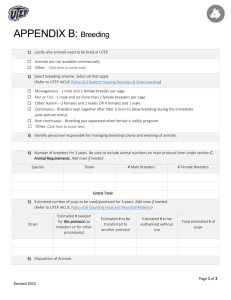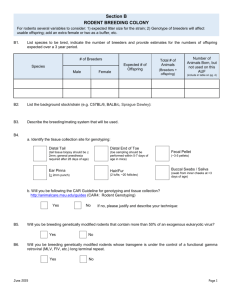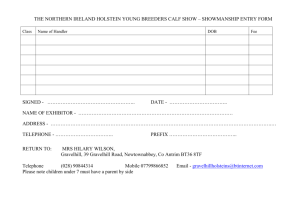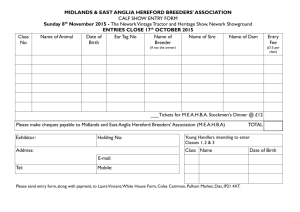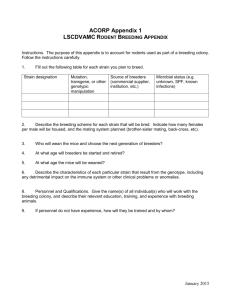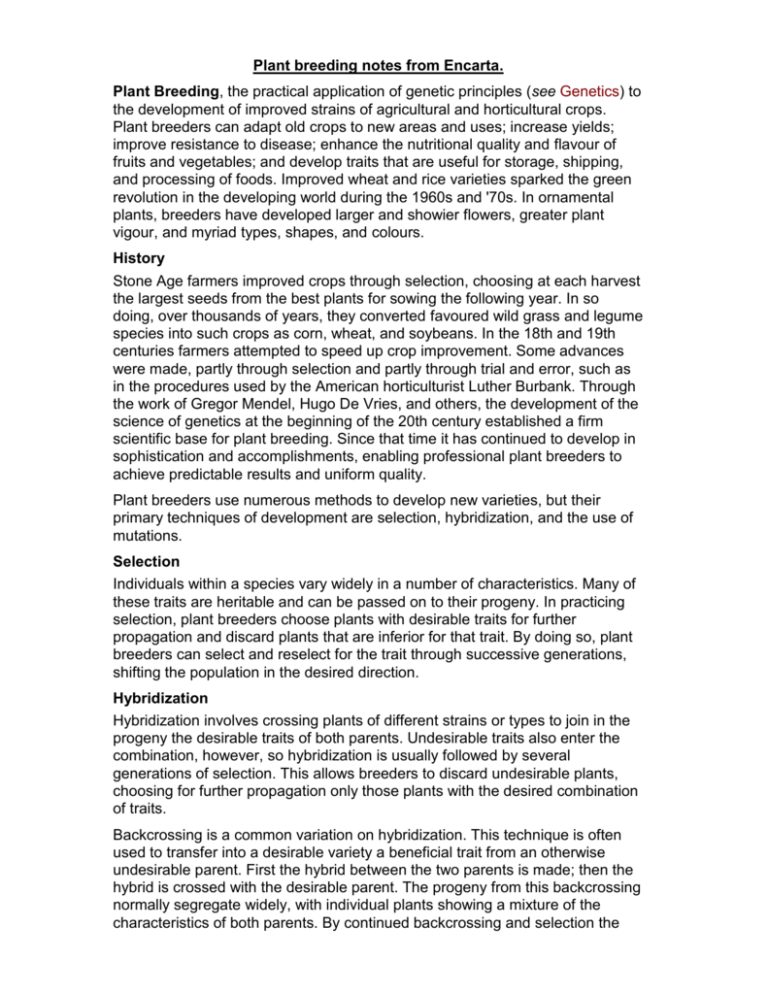
Plant breeding notes from Encarta.
Plant Breeding, the practical application of genetic principles (see Genetics) to
the development of improved strains of agricultural and horticultural crops.
Plant breeders can adapt old crops to new areas and uses; increase yields;
improve resistance to disease; enhance the nutritional quality and flavour of
fruits and vegetables; and develop traits that are useful for storage, shipping,
and processing of foods. Improved wheat and rice varieties sparked the green
revolution in the developing world during the 1960s and '70s. In ornamental
plants, breeders have developed larger and showier flowers, greater plant
vigour, and myriad types, shapes, and colours.
History
Stone Age farmers improved crops through selection, choosing at each harvest
the largest seeds from the best plants for sowing the following year. In so
doing, over thousands of years, they converted favoured wild grass and legume
species into such crops as corn, wheat, and soybeans. In the 18th and 19th
centuries farmers attempted to speed up crop improvement. Some advances
were made, partly through selection and partly through trial and error, such as
in the procedures used by the American horticulturist Luther Burbank. Through
the work of Gregor Mendel, Hugo De Vries, and others, the development of the
science of genetics at the beginning of the 20th century established a firm
scientific base for plant breeding. Since that time it has continued to develop in
sophistication and accomplishments, enabling professional plant breeders to
achieve predictable results and uniform quality.
Plant breeders use numerous methods to develop new varieties, but their
primary techniques of development are selection, hybridization, and the use of
mutations.
Selection
Individuals within a species vary widely in a number of characteristics. Many of
these traits are heritable and can be passed on to their progeny. In practicing
selection, plant breeders choose plants with desirable traits for further
propagation and discard plants that are inferior for that trait. By doing so, plant
breeders can select and reselect for the trait through successive generations,
shifting the population in the desired direction.
Hybridization
Hybridization involves crossing plants of different strains or types to join in the
progeny the desirable traits of both parents. Undesirable traits also enter the
combination, however, so hybridization is usually followed by several
generations of selection. This allows breeders to discard undesirable plants,
choosing for further propagation only those plants with the desired combination
of traits.
Backcrossing is a common variation on hybridization. This technique is often
used to transfer into a desirable variety a beneficial trait from an otherwise
undesirable parent. First the hybrid between the two parents is made; then the
hybrid is crossed with the desirable parent. The progeny from this backcrossing
normally segregate widely, with individual plants showing a mixture of the
characteristics of both parents. By continued backcrossing and selection the
plant breeder concentrates the qualities desired, and, if all goes well, in six or
seven generations the variety once again breeds true but now exhibits its new
trait. Backcrossing is valuable for adding single gene characteristics to crop
plants, particularly for resistance to specific insects and diseases.
When desirable characteristics are fully developed in a hybrid plant and the
plant can be propagated asexually by budding, grafting, or cloning, and then no
further selection is necessary. A hybrid apple, for example, is propagated by
grafting, so all resultant plants are identical.
Hybrids are often more vigorous than either parent. This phenomenon is called
hybrid vigour and has been widely used by plant breeders to increase crop
yields. Hybrid seeds have helped to double U.S. corn yields since the 1940s,
and almost all the corn now grown in the United States and Europe is started
annually from hybrid seed. Hybrid breeding has expanded in recent years, and
hybrid varieties are now common in grain crops (corn, sorghum), vegetables
(cabbage, tomatoes, squash), and many flower species.
Mutation
Occasionally an individual plant shows an important change in one or more
traits arising from a spontaneous mutation. Usually a change in a single gene is
involved. Most mutations are deleterious, but occasionally one has a distinct
advantage. The plant showing the mutation may be used directly as a variety, a
common practice in apples and other fruits, or the new trait may be added to
existing varieties through hybridization and backcrossing. Plant mutations
caused by single-gene changes have found wide use in ornamentals, resulting
in double-flowered forms, weeping stems, dwarfism or unusual growth habits,
and a wide diversity of colour variations. Mutations can be induced artificially by
X rays or ultraviolet light.
Doubling the number of chromosomes is another plant-breeding technique that
has been useful in improving some flower and crop plants, sometimes
producing forms with increased vigour and with larger leaves, flowers, and
fruits. The chemical colchicine, an alkaloid extracted from the autumn crocus, is
useful for this purpose.
New Techniques
Developments in plant tissue culture and genetic engineering are opening up
new opportunities for plant breeders. In tissue culture, a single laboratory dish
of plant cells can be the equivalent of a field with thousands of plants from
which to select improved strains. As genetic engineering techniques are
perfected, breeders may be able to transfer a gene for pest resistance to a crop
plant directly from a wild relative or even from an unrelated species, thus
reducing the need for pesticides over vast fields of crops. Such attempts were
meeting with only quite limited success by the late 1980s, however, and genetic
modification through somoclonal variation techniques may prove more
immediately useful.1
1"Plant Breeding," Microsoft® Encarta® 98 Encyclopedia. © 1993-1997 Microsoft
Corporation. All rights reserved.
Plant breeding worksheet.
What is the general aim of plant breeders?
_____________________________________________________________
What specific improvements are breeders trying to achieve relating to productivity?
_____________________________________________________________
_____________________________________________________________
What specific improvements are breeders trying to achieve relating to marketing of
produce?
_____________________________________________________________
_____________________________________________________________
What is selection?
_____________________________________________________________
_____________________________________________________________
What is hybridisation?
_____________________________________________________________
_____________________________________________________________
What specific advantages does backcrossing offer the breeder?
_____________________________________________________________
_____________________________________________________________
What is hybrid vigour?
_____________________________________________________________
_____________________________________________________________
What are some examples of crops that are improved by taking advantage of hybrid
vigour?
_____________________________________________________________
What is a mutation?
_____________________________________________________________
_____________________________________________________________
_____________________________________________________________
Genetic engineering is a technique that breeders can use to insert specific genes that
improve the production of a plant. What example was given in the handout of a quality
that a gene can give a plant?
_____________________________________________________________
Answers
Plant breeding worksheet.
What is the general aim of plant breeders?
To improve the plants
What specific improvements are breeders trying to achieve relating to productivity?
Fruit size, resistance to pests, fruitfulness
What specific improvements are breeders trying to achieve relating to marketing of
produce?
storage qualities, processing alternatives
What is selection?
Selecting the best plants from a population to make sure the best parents are
used in the hope that their offspring and future generations will give
improved results
What is hybridisation?
Crossing plants of different strains or types to join in the progeny the
desirable traits of both parents
What specific advantages does backcrossing offer the breeder?
Adding single gene characteristics to crop plants
What is hybrid vigour?
Hybrids are often more vigorous the grow faster and produce more than
either parent
What are some examples of crops that are improved by taking advantage of hybrid
vigour?
Grain crops (corn, sorghum), vegetables (cabbage, tomatoes, squash), and
many flower species. Crops that are grown from seed each year
What is a mutation?
A change in the genetic make up of a plant due to mistakes in the formation
of the genes during cell division or because of environmental things like
radiation.
Genetic engineering is a technique that breeders can use to insert specific genes that
improve the production of a plant. What example was given in the handout of a quality
that a gene can give a plant?
Pest resistance


